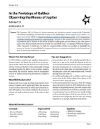The Galileoscope Project
From Pinholes to Space Telescopes: Using the Galileoscope to Help Learners of All Ages Understand How Telescopes Work
Developed in 2009 for the International Year of Astronomy, the Galileoscope has become the centerpiece for teaching about telescopes in many programs. As a key component of the Galileo Teacher Training Program, the Astronomical Society of the Pacific has engaged hundreds of educators in professional development related to telescopes and the Galileoscope.
In 2017, thanks to funding from the Gordon and Betty Moore Foundation, the ASP expanded its resource and professional development offerings related to the Galileoscope. This includes a series of in-person and online workshops, articles, and videos to support the use of the Galileoscope in a variety of educational settings.
Workshops and Professional Development
A complete list of workshops and registration information is available here.
Videos
Exploring Apertures: The “Hole” Story
Coming Into Focus: Organizing Light With Lenses
Building Your Galileoscope: A Step-by-Step Guide
The Practical Galileoscope: Getting Started with Your First Observations
Articles and Activities
Discover how to incorporate Galileo-inspired activities into your classroom or other educational venue. From investigating how telescopes work, to recreating Galileo’s observations of the moons of Jupiter and the phases of Venus, the Galileoscope is a marvelous tool for teaching about light, optics, and the tools astronomers use to probe distant phenomena.
-
The Universe in the Classroom Winter 2018
While most people have a basic idea of how lenses work, they frequently don’t know how telescopes use lenses and mirrors together to organize light to form images of distant objects. Through a simple sequence of activities, learners of any age can explore the behavior of light through the use of a simple pinhole viewer and lenses of differing focal lengths. Exploring the properties of both light and lenses will help learners incrementally develop a more complete mental model of how light behaves, and how lenses work together in a simple refracting telescope.
In this edition of The Universe in the Classroom, explore an instructional sequence where learners investigate what pinhole viewers and giant telescopes have in common through using lenses to construct a basic model of a telescope.
-
This is activity C13 from The Universe at Your Fingertips 2.0, a DVD-ROM resource collection for teaching astronomy.
Please click on the thumbnail to view and/or download this activity.
This activity was developed for the International Year of Astronomy in 2009 as a hands-on, inquiry-based activity simulating Galileo’s observations of the four large moons of Jupiter to provide a participatory demonstration of how science works.
-
This is activity C10 from The Universe at Your Fingertips 2.0, a DVD-ROM resource collection for teaching astronomy.
Please click on the thumbnail to view and/or download this activity.
The most direct and dramatic proof of the heliocentric model of the solar system came from Galileo’s observations of the phases (different appearances of sunlit and dark areas) on the disk of the planet Venus as seen through his telescope. Here students learn about phases and then compare the motion of Venus around the Sun in two models and how it would produce phases as seen from Earth.
Additional Resources
Go beyond the ASP website to find resources useful in teaching about telescopes, and in particular the Galileoscope.
-
Explore pinholes and how you can use them to investigate a variety of phenomena related to light, optics, color, and art.
Please visit the Exploratorium website or click on the thumbnail to view and/or download this activity.
-
This site features the Galileoscope Optics and Observing Guides.
-
 This project is funded by the Gordon and Betty Moore Foundation.
This project is funded by the Gordon and Betty Moore Foundation.


